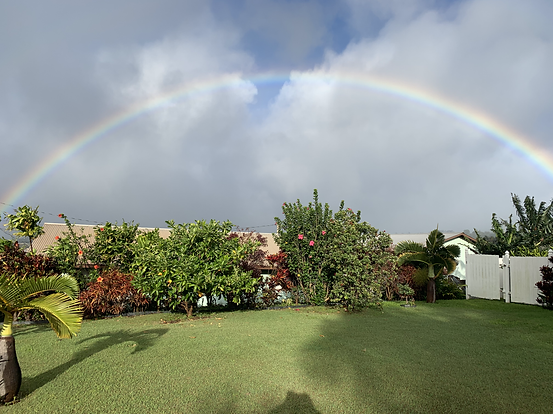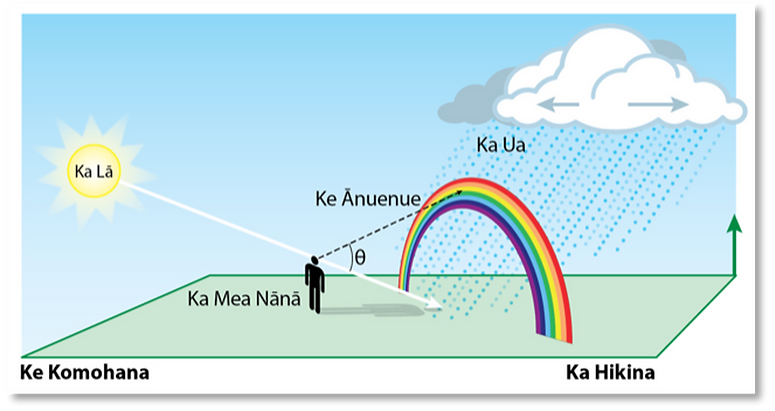
The Full Arching Rainbow
The features of the full arching rainbow
According to the Hawaiian-English dictionaries, this is the definition o this type of rainbow:
Pukui/Elbert: 1. nvs., Arch, arc; bent, arched, curved; to arch, of a rainbow.
Parker: 1. v., To be bent; to be curved; to bend around as the arch of a rainbow; to curve as an arch; to bend as an elastic substance.
Primary trait: A rainbow with one full arch
Secondary trait: A rainbow with the majority of all the colors
A full arching rainbow (na Hoaloha Westcott)
The sky strata that the full arching rainbow appears
This type of rainbow appears in a part of the lewa lani lewa, the lewa nuʻu, and the lewa lani.[1] It often appears above the land, above the ocean, and sometimes above both the land and the ocean. There are examples of this within Hawaiian stories such as Hiʻiakaikapoliopele.[2]
From the scientific perspective, the sun needs to be in a specific position on itʻs path in order for a rainbow to appear. Namely 42 degrees or less above the horizon.[3] Therefore, the sun needs to be in the position of Kahikikū, Kahikikepapanuʻu, or approximately half way between
Kahikikepapanuʻu and Kahikikepapalani. The rainbow appears at the anti-solar point, therefore, when the sun is in the west, the rainbow appears in the east, and when the sun is in the east the rainbow appears in the west.[4] The relationship of the positions of the sun, the observer, and the rainbow are shown in the figure below.
The position of the sun in relation to the rainbow
The altitude of the top of the rainbow depends on the angle of the sun above the horizon. At the time of sunrise or sunset, the rainbow is in the high sky strata, namely the lewa nuʻu or the lewa lani. As the sun rises, the rainbow descends and appears in the lewa lani lewa. When the position of the sun exceeds 42 degrees above the horizon, the rainbow disappears below the horizon. The relative altitude of sun and rainbow are shown in the see-saw figure below
The relationship of the positions of the sun and rainbow
The height of the rainbow
Therefore:
-
Sun is low --> Rainbow is high
-
Sun is high --> Rainbow is low
The height that the rainbow appears in the sky is perhaps explained by the scientific perspective, namely the geometry of the sun the observer and the rainbow. However, there are many examples of a rainbow that appears at geometries other than the western science view.
Times that the rainbow appears.
In the Hawaiian perspective, rainbows can appear at any time of the day or night, because it is the responsibility of the gods to direct the appearing of the rainbow. In the scientific perspective, it is the geometry of the sun, the observer, and the atmospheric moisture that is responsible. However, there are numerous examples within the traditional Hawaiian stories of a rainbow appearing at other times in opposition to western scientific knowledge. These examples are shown in other pages on the Hawaiian side of this website.
As a way to understand the western scientific perspective, there are 3 requirements for a rainbow to appear in the sky, as follows:
-
The sun must be at an appropriate angle above the horizon
-
The sun must be behind the observer
-
The water drops in the sky must be of an appropriate size
The scientific reason that the rainbow appears in the sky is the reflecting and refracting of the suns rays within water drops. Therefore, there is a need for suspended water drops/droplets to be present in the sky. Looking at the diagram below, at the time that the sun rays enter the surface of the water drop, they are refracted due to the density of the water, because, the density of the water drop is larger than the density of air. The mathematical formula that explains this phenomenon is Snellʻs law. As a result of the refraction, the white light is separated into color bands. The colors travel to the back of the water drop and are reflected back towards the front of the drop, at which point the refract again as a result of leaving the drop and entering the air.[5]
The colors within a water drop
The full rainbow has 7 colors (although technically it is a continuous gradient of colors), with the red at the bottom and violet at the top. However, the sequence of colors we see in the rainbow is opposite, why is this? Geometry is the reason. Refer to the diagram below. The top of the rainbow appears at 42 degrees above the observer, and since the violet color is higher than violet when it emerges from the water drops, the colors other than red pass above the observer. The base of the rainbow appears at 40 degrees above the observer, since the height of the red color is lower, violet is the only color seen at the bottom of the rainbow, and the other colors pass below the observer.[6]
The reason for the color order
Rainbows are actually full circles, but, only a part of the circle is seen above the horizon[7] The remainder of the circle is below the horizon. Therefore, the part that is seen above the horizon appears as an arch. If the horizon was not blocking, the entire circle could be seen.[8] Refer to the diagram below. If the observer was in an airplane, the entire circle of the rainbow can be witnessed.
The full circle of the rainbow
The area inside the rainbow is brighter than the area outside. Why is this? The water drops in the atmosphere that are located at 40-42 degrees create the rainbow. The water drops at other angles only reflect the white sun light.[9] This reflect white light is directed to the center of rainbow circle, therefore the center of the rainbow is brighter than the outside.[10] This shown in the picture below.
The bright area below the arc (na Clinton Gaughran)
The signs of the full arching rainbow
There were 16 signs/omens found within the sources analyzed for the full arching rainbow. There are 145 occurrences of these signs/omens, and the signs concerning a presence were the most numerous (70). The Chi-square goodness-of-fit test was performed on the data, and the result is that the data varies significantly from an equal distribution and therefore one or more of the groups is significantly different than the others from a mathematical perspective. Which group(s)? Perhaps it is the group of signs concerning a presence since it is the most numerous.
The Signs/omens of the full arching rainbow
Translation Key
Examples for each of the signs/omens for the full arching rainbow are shown on the Hawaiian pages and are not available in English at this time. However, there are two examples below.
The rainbow is often seen at the time an aliʻi is born. This can be seen at the the time Kamehameha V was born, as follows (translated quote):
"...As for the day of the King, it was the day he emerged from the stomach of his mother, and on that day, the land was dark, the clouds dwelled ominously, the heavenly source was sturdy, apart and few, the ocean was stormy, the waves were agitated, the wind was conflicted, the extremes of the earth were in alliance, the rainbows arched, the thunder roared..."[11]
This is a story that was told by Alice Sharden on the radio show “Ka Leo Hawaiʻi” (The Hawiian Voice) in the year 1974. This story was told to her by her mother about the funeral of her grandfather ( The great grandfater of Alice Sharden). The great grandfather was an important. He was prominent in his days. After his passing the corpse was wraped in tapa. He was firmly covered and laid to rest in his canoe. He was carried to a cave up in the mountains (on the island of Hawaii) and burried inside the cave. The funeral was performed and after that the family started to return back down. While they were walking, the rain started in front of them, namely the blood rain, the blood red rain. Some people turned to look behind a the aforementioned canoe was seen floating in the air, and carried the spirit of the great grandfather was carried. That canoe was carried directly above the crater (of the volcano). On a rainbow that canoe was carried. The rainbow arched from the cave until inside the crater. The canoe lowered into the crater. The great grandfather belonged to the Pele family and it was said by the people, he is returning to his proper place.[12]
[1] Joseph Nawahi, "Ke Anuenue a me Ka Luakalailani." Ka Leo o ka Lahui, Mei 24, 1893: 2-3.
[2] Hoʻoulumāhiehie 1906, 2006. Ka Moʻolelo o Hiʻiakaikapoliopele. Edited by Puakea Nogelmeier. Honolulu, HI: Awaiaulu. ʻaoʻao 232.
[3] k.l., Carl B. Boyer (1987). The Rainbow: From Myth to Mathematics. Princeton, NJ: Princeton University Press.
[4] Stevin Businger. 2021. "The Secrets of the Best Rainbows on Earth." Bulletin of the American Meterological Society 102 (2): E338-E350.
[5] Judith Donnelly and Nicholas Massa. 2018. LIGHT: Introduction to Optics and Photonics. Pittsfield: Photonics Media Press; Laurin Publishing Co. Inc. ʻaoʻao 79.
[6] k.l.
[7] Myses H. Nussenzveig. 1980. "The Theory of the Rainbow." In Light From the Sky, by Scientific American. San Francisco, CA: W. H. Freeman and Company. ʻaoʻao 56.
[8] David Lynch and William Livingston. 1995. Color and Light in Nature. Cambridge: Press Syndicate of the Unversity of Cambridge. ʻaoʻao 103
Steven Businger. 2021. "The Secrets of the Best Rainbows on Earth." Bulletin of the American Meterological Society 102 (2): E338-E350.
[9] k.l.
[10] ʻO kekahi huina kūpono ʻole, e kau ana i nā huna wai i kekahi huina ¹ 42 degrees.
[11] Niniukawai. (1866, 24 December). La Hanau o ka Moi. Ke Au Okoa. ʻaoʻao 1.
[12] Alice Sharden, ua nīnauele ʻia e Larry Kimura. 1974. "HV24.58A1 (kelepona kūloko)." Ka Leo Hawaiʻi. Lekiō KCCN, (Malaki 10).










na Hoaloha Westcott